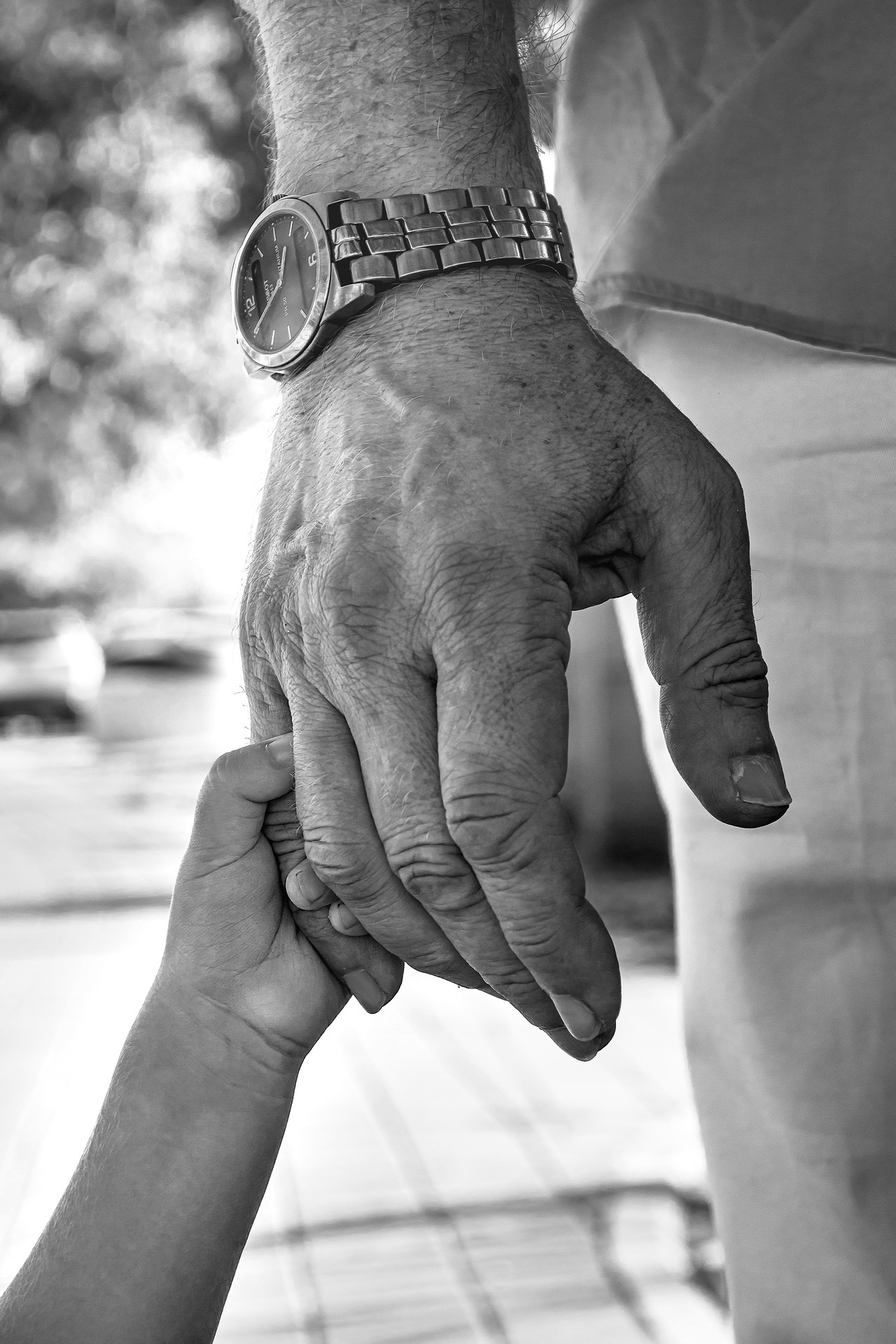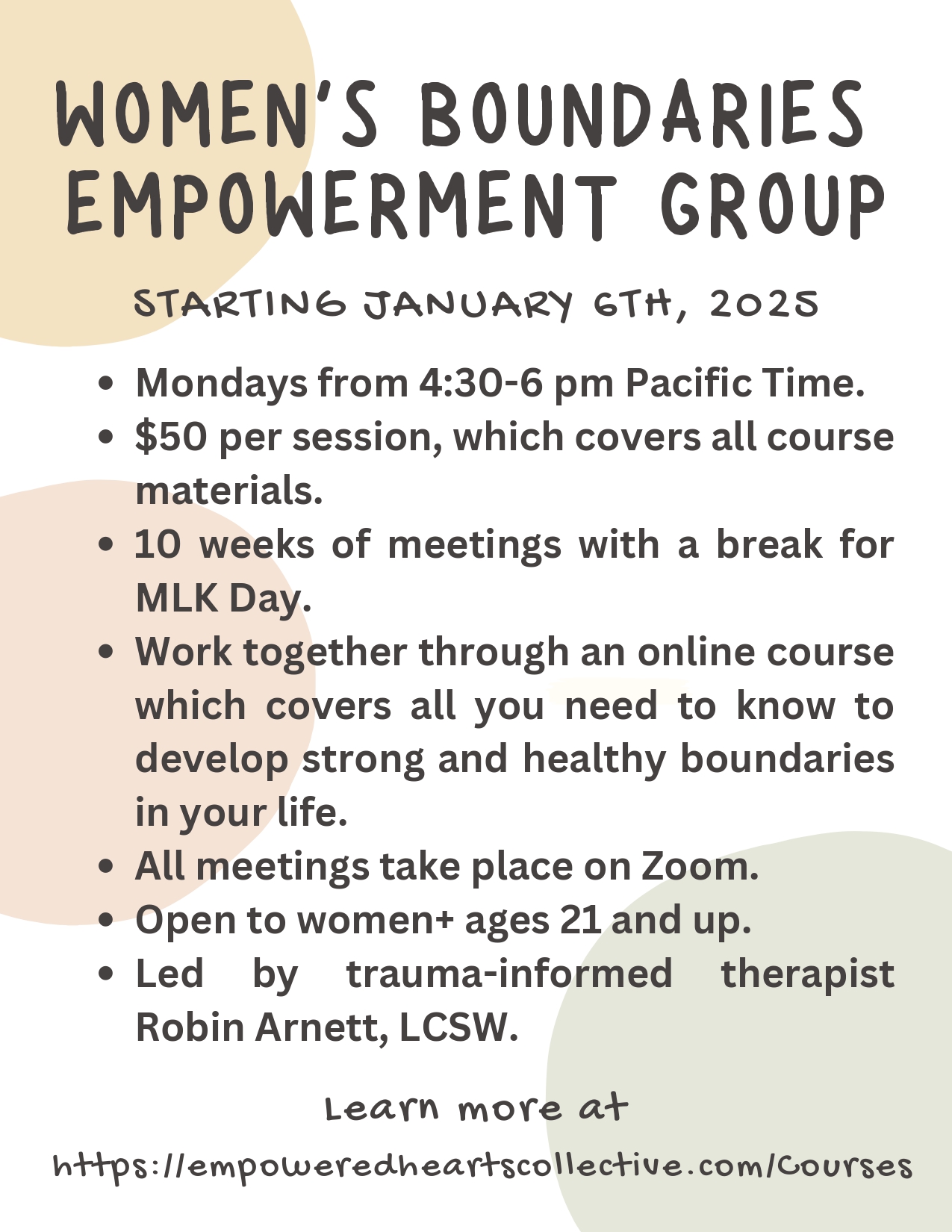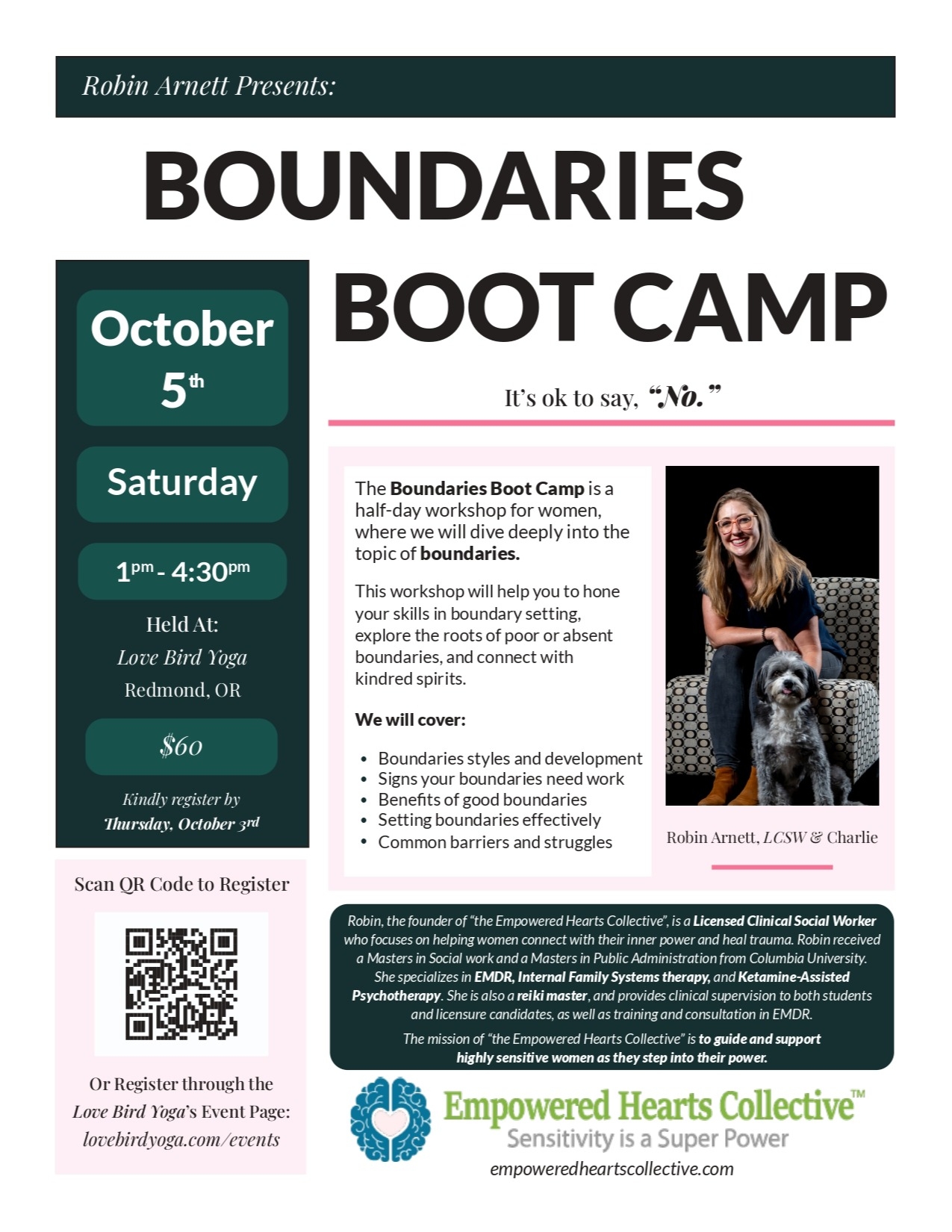Take the first step to stronger boundaries—unlock your free course, Module 7: Setting Effective Boundaries, from the Intuitive Boundaries Mastery Series.
Unlock Free ModuleThree Steps to Building Secure Attachment
Building the Elements of a Strong Bond
By Robin Arnett
“Secure attachment” is key to experiencing healthy, happy connections throughout our lives.
You may have heard something about how our attachment style helps determine how we show up in adult relationships. Attachment is a popular topic right now on Instagram and TikTok, and Heller and Levine’s “Attached” has been a popular primer on the topic for a few years now. Our attachment style also influences how we set boundaries (or don't).
Elements of secure attachment are relevant whether you are looking to provide a secure attachment to your loved ones, or if you are simply seeking healthy relationships for yourself as an adult.
So, if secure attachment is so important, how is it developed?
There are three components to how we go about developing secure attachment relationships, both as children and as adults.
Secure attachment involves:
You may have heard something about how our attachment style helps determine how we show up in adult relationships. Attachment is a popular topic right now on Instagram and TikTok, and Heller and Levine’s “Attached” has been a popular primer on the topic for a few years now. Our attachment style also influences how we set boundaries (or don't).
Elements of secure attachment are relevant whether you are looking to provide a secure attachment to your loved ones, or if you are simply seeking healthy relationships for yourself as an adult.
So, if secure attachment is so important, how is it developed?
There are three components to how we go about developing secure attachment relationships, both as children and as adults.
Secure attachment involves:
- Attunement
- Containment
- Repair following rupture
Keep these elements in mind to build your skills as a caregiver, partner, and friend, and to gauge the health of your relationships with your own attachment figures.
Building Attunement in Secure Attachment
“Attunement” essentially means tuning in to what’s going on with another person. Another way to think of attunement is simply as paying attention. When we are attuned to another person, whether they are a peer or someone under our care, we are aware of their mood, their body language, and their energy, and we take steps to engage with whatever is showing up.
We also pay attention over time to patterns, preferences, and personality traits. Being attuned is how we come to really know another person, which fulfills a deep longing in the person to whom we are attuned. How incredibly comforting is it when somebody that we care about notices that something is off with us, even if it’s subtle? The same is true when someone pays attention to what brings us joy and makes us who we are. We feel seen and valued, and we feel that we matter.
In her song “We Can Do Hard Things,” young songwriter Tish Melton proclaims that “to be loved, we need to be known.” I would take that a step further to say that in being known, we are loved. This is true in adult relationships and in relationships between children and caregivers. Attunement is the path to this knowing.
We also pay attention over time to patterns, preferences, and personality traits. Being attuned is how we come to really know another person, which fulfills a deep longing in the person to whom we are attuned. How incredibly comforting is it when somebody that we care about notices that something is off with us, even if it’s subtle? The same is true when someone pays attention to what brings us joy and makes us who we are. We feel seen and valued, and we feel that we matter.
In her song “We Can Do Hard Things,” young songwriter Tish Melton proclaims that “to be loved, we need to be known.” I would take that a step further to say that in being known, we are loved. This is true in adult relationships and in relationships between children and caregivers. Attunement is the path to this knowing.
Attunement and Safety
Knowing that we matter in our loved ones’ eyes not only nurtures strong bonds, but it helps to grow an internal sense of worthiness and safety, especially in children. Attunement often shows up between a caregiver and their child when the caregiver notices their children’s hunger, fatigue, distress, etc., and then takes action to address those needs. In addition to building worthiness, attunement followed by action grows an internal sense of security in the world.
Children quite literally depend on their caregivers for survival, so when it comes to attunement, the stakes are as high as they could be. Of course, all parents must allow themselves grace for mistakes and misattunements (that’s where repair after rupture comes in), but it’s important to remember that this is why attachment concerns can still feel like life or death in adulthood. We carry this stuff inside of us.
When caregivers do consistently attune to and meet their children’s needs, this builds a sense that we can move beyond survival and into the higher tiers of our hierarchy of needs to live a fuller, richer life.
The interesting irony to secure attachment is that the stronger your home base, the more you’ll be curious to explore, because you know you have something solid to return to. Secure attachment also builds confidence, which is essential for going outside our comfort zones. Being attuned to helps us feel loved, seen, safe, secure, and confident.
Children quite literally depend on their caregivers for survival, so when it comes to attunement, the stakes are as high as they could be. Of course, all parents must allow themselves grace for mistakes and misattunements (that’s where repair after rupture comes in), but it’s important to remember that this is why attachment concerns can still feel like life or death in adulthood. We carry this stuff inside of us.
When caregivers do consistently attune to and meet their children’s needs, this builds a sense that we can move beyond survival and into the higher tiers of our hierarchy of needs to live a fuller, richer life.
The interesting irony to secure attachment is that the stronger your home base, the more you’ll be curious to explore, because you know you have something solid to return to. Secure attachment also builds confidence, which is essential for going outside our comfort zones. Being attuned to helps us feel loved, seen, safe, secure, and confident.
Building Containment in Secure Attachment
Children first learn to regulate their emotions with the help of their caregivers in a process called co-regulation. Containment is the act of containing whatever is happening in the room through co-regulation.
Between children and their caregivers, containment means that the child gets to experience their big emotions without fearing that they will put their caregiver over the edge. For example, when a child is having a tantrum, it’s the adult’s job to stay calm, rather than allowing that adult’s reaction to the tantrum to become the focal point. Between adults, this might look like knowing you can go to your friend with your grief over a loss without making them uncomfortable or fearing that you will trigger them.
Self-compassion expert Kristin Neff gives a great example of co-regulation in her TEDTalk on self-compassion vs. self-esteem. She talks about flying to Europe with her son, who struggles with sensory overload, and having him throw an epic tantrum mid-flight. Dr. Neff talks about feeling the annoyed glares of the other passengers burning into her as she considered what to do. Of course, she was concerned for her son, but checked in with herself first and foremost, making sure she was calm and stable before attempting to address the problem. Her calm energy helped her son to regulate as she soothed him.
Both children and adults feel safer with people that they know have access to their own emotional regulation tools and that are adaptable in the face of stress. Containment speaks to self-care and self-regulation, which speaks to safe, healthy people.
Between children and their caregivers, containment means that the child gets to experience their big emotions without fearing that they will put their caregiver over the edge. For example, when a child is having a tantrum, it’s the adult’s job to stay calm, rather than allowing that adult’s reaction to the tantrum to become the focal point. Between adults, this might look like knowing you can go to your friend with your grief over a loss without making them uncomfortable or fearing that you will trigger them.
Self-compassion expert Kristin Neff gives a great example of co-regulation in her TEDTalk on self-compassion vs. self-esteem. She talks about flying to Europe with her son, who struggles with sensory overload, and having him throw an epic tantrum mid-flight. Dr. Neff talks about feeling the annoyed glares of the other passengers burning into her as she considered what to do. Of course, she was concerned for her son, but checked in with herself first and foremost, making sure she was calm and stable before attempting to address the problem. Her calm energy helped her son to regulate as she soothed him.
Both children and adults feel safer with people that they know have access to their own emotional regulation tools and that are adaptable in the face of stress. Containment speaks to self-care and self-regulation, which speaks to safe, healthy people.
Building Secure Attachment through Rupture with Repair
Think about the people in your life that you feel safest with. It’s likely that these are people that you know well, that you’ve known for a long time, and that you’ve been through some tough times with. Going through rupture followed by healthy repair helps us to feel like our relationships are resilient.
Healthy repair after a rupture has a few elements to it. It looks like:
Healthy repair after a rupture has a few elements to it. It looks like:
- Apologizing
- Taking ownership
- Witnessing injuries
- Addressing wounds
- Learning from mistakes
This dynamic goes both ways—we feel secure when somebody initiates a repair with us, and we also experience emotional safety when we receive forgiveness following a repair attempt.
We all have times when we show up in ways that we don’t like, and do and say things that we wish we hadn’t. Although the goal is that we work to heal our wounds so that this “ugly” shows up less often, it’s important to have people in our lives that know our hearts, and that can forgive us when we mess up.
People in positions of authority often feel like if they “admit” that they messed up, their role and status will be diminished. In fact, the opposite is true. When we acknowledge the hurt that we’ve caused another person and take steps to fix it, we earn their respect, whether that person is a child or an adult. Repair also contributes to the feeling of being seen. Making a point of repair shows someone that they matter to you more than your ego.
There’s a caveat to this piece, which is that repeated, intractable rupture will inevitably lead to a lack of safety, no matter how much repair happens afterward. Part of repair means learning from our mistakes and doing things differently going forward, which should lead to reduced conflict in the future.
We all have times when we show up in ways that we don’t like, and do and say things that we wish we hadn’t. Although the goal is that we work to heal our wounds so that this “ugly” shows up less often, it’s important to have people in our lives that know our hearts, and that can forgive us when we mess up.
People in positions of authority often feel like if they “admit” that they messed up, their role and status will be diminished. In fact, the opposite is true. When we acknowledge the hurt that we’ve caused another person and take steps to fix it, we earn their respect, whether that person is a child or an adult. Repair also contributes to the feeling of being seen. Making a point of repair shows someone that they matter to you more than your ego.
There’s a caveat to this piece, which is that repeated, intractable rupture will inevitably lead to a lack of safety, no matter how much repair happens afterward. Part of repair means learning from our mistakes and doing things differently going forward, which should lead to reduced conflict in the future.
Taking Stock in the Present
Take an inventory of the relationships in your life. How much or how little is each of these elements present in them? See if you can recognize how safe or unsafe they feel based on how much attunement, containment, and rupture with repair you’ve experienced.
Secure attachment can always be nurtured and grown with intention. If you didn’t get to experience secure attachment through your childhood caregivers, working with a therapist to address attachment trauma and experiencing secure relationships as an adult can help to heal those wounds.
Reach out to learn more about growing your ability to engage in secure attachment relationships to live a fuller and more connected life.
Secure attachment can always be nurtured and grown with intention. If you didn’t get to experience secure attachment through your childhood caregivers, working with a therapist to address attachment trauma and experiencing secure relationships as an adult can help to heal those wounds.
Reach out to learn more about growing your ability to engage in secure attachment relationships to live a fuller and more connected life.


